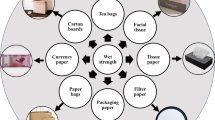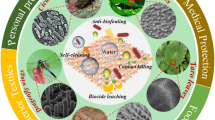Abstract
Aluminum ammonium sulfate was used as a new catalyst for glyoxal to minimize the decrease of physical properties of durable press cotton fabrics, and the optimum treatment conditions such as the concentration of glyoxal, molar ratio of catalyst to glyoxal, curing temperature and time were investigated. The retention of tensile strength and the whiteness of fabrics treated with glyoxal/aluminum ammonium sulfate was increased as much as to the degree of that obtained with glyoxal/aluminum sulfate while wrinkle recovery angles were as good as those of the latter. Some additives such as DEG, polyurethane and softener were used to improve the physical properties. When DEG or polyurethane was added to the glyoxal padding solution, wrinkle recovery angle (WRA) significantly increased while tensile strength and whiteness were not influenced. DEG added to the glyoxal padding solution increased the durability of DP finish. The softener added to the glyoxal padding solution increased the WRA of treated fabrics while it decreased the tensile strength slightly. The whiteness of fabrics treated with glyoxal alone increased while the WRA decreased slightly.
Similar content being viewed by others
References
B. H. Kim, J. H. Jang, and S. W. Ko, Fiber. Polym., 1, 116 (2000).
J. H. Jang, K. C. Yoon, and S. W. Ko, Fiber. Polym., 2, 184 (2001).
H. M. Choi and Y. M. Kim, Fiber. Polym., 2, 190 (2001).
C. M. Welch, Text. Res. J., 58, 480 (1988).
C. W. M. Yuen, C. W. Kan, and H. L. Lee, Fiber. Polym., 7, 139 (2006).
C. M. Welch and B. A. Kottes-Andrews, Am. Dyestuff Rep., 74, 15 (1985).
C. Q. Yang and B. A. Kottes-Andrews, J. Appl. Polym. Sci., 43, 1609 (1991).
H. M. Choi and C. M. Welch, Am. Dyestuff Rep., 83(12), 48 (1994).
J. R. Park, E. S. Lee, and S. W. Ko, J. Korean Fiber Soc., 33, 429 (1996).
N. J. Lim, E. S. Lee, and S. W. Ko, J. Korean Fiber Soc., 34, 517 (1997).
E. J. Gonzales and J. D. Guthrie, Am. Dyestuff Rep., 58(3), 27 (1973).
D. L. Worth, U. S. Patent, 4269603 (1981).
C. M. Welch, Text. Res. J., 53, 181 (1983).
D. L. Worth and E. A. Freeman, U. S. Patent, 4269602 (1981).
C. M. Welch, Text. Chem. Color., 16, 265 (1984).
E. S. Lee and S. I. Kim, Fiber. Polym., 5, 230 (2004).
Y. S. Im, H. K. Lee, and S. W. Ko, J. Korean Fiber Soc., 30, 759 (1993).
I. G. Park and Y. H. Kim, J. Korean Fiber Soc., 29, 599 (1992).
B. H. Jang, S. W. Nam, and M. Sakamoto, J. Korean Fiber Soc., 24, 68 (1987).
B. G. Simpson, Text. Res. J., 28, 170 (1958).
Author information
Authors and Affiliations
Corresponding author
Rights and permissions
About this article
Cite this article
Yu, Y.H., Lee, E.S. & Bang, E.S. A new catalyst for glyoxal durable press finish of cotton fabrics. Fibers Polym 9, 715–719 (2008). https://doi.org/10.1007/s12221-008-0112-3
Received:
Revised:
Accepted:
Published:
Issue Date:
DOI: https://doi.org/10.1007/s12221-008-0112-3




